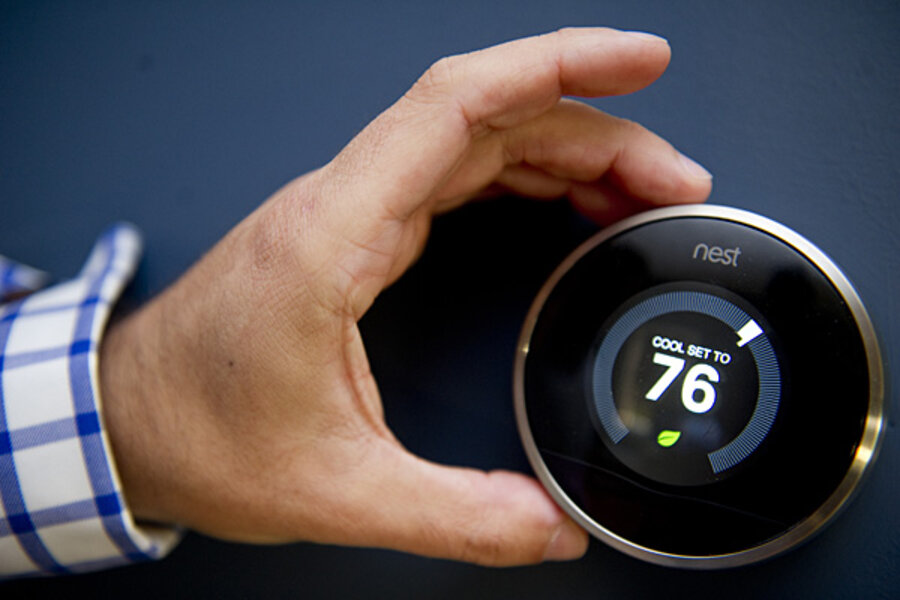Your home is about to get a lot smarter, and so is everything else
Loading...
On Wednesday, Nest Labs will hold its first press conference since being acquired by Google for $3.2 billion last January. The company, which is known for its “smart” home appliances that connect to the Internet, has so far released two products: a thermostat and Nest Protect, a smoke and carbon monoxide (CO) detector.
Both products connect to a user’s smart phone, and can communicate with other appliances in a person’s home to maximize energy efficiency and prevent damage. For example, if the Nest Protect detects carbon monoxide, it can have a Nest Thermostat shut off a home’s furnace – often the cause of CO leaks. To many, Nest has made waves as one of the few consumer companies to break into the “Internet of Things.”
The “Internet of Things” (IoT) describes products, objects, and services linked to the Internet. Different from computers or smart phones, these are devices that fundamentally serve a purpose separate from the Internet but are augmented by their connection to it.
While many people know the term contemporarily to mean smart watches or refrigerators that tell us the weather, the term is much broader and encompasses anything from sensors that track your FedEx package to chips that monitor the health of cattle.
To Ryan Budish, a fellow at Harvard University’s Berkman Center for Internet & Society, the Internet of Things means that “anything that can be connected to the Internet will be.”
“The benefits are tremendous,” says Mr. Budish. From immediate convenience and comfort to bridging the information gap, the Internet of Things has applications across many fields. Budish gives two examples to detail the scope of the Internet of Things: mobile payment systems such as Android Pay or Apple Pay and automatic airplane maintenance checks – such as sensors embedded into machinery to report back its health and issue alerts before it fails.
Budish studies interoperability, or the many layers through which technology interacts. In the example of airplane maintenance checks, there are several layers of interoperability. A sensor must check if the engine is functioning properly by understanding how it works and when it’s not working appropriately. It must then relay that information to the airplane’s network, which then relays that to a console on the ground. The ground crew must be able to decipher the message given and use that to fix the plane when it lands.
“The interoperability comes into play because in order for all of that to happen, you need all of these systems to be able to talk to each other – to interoperate,” says Budish.
Advancements in computing technology over the past several years has made this application possible. With smaller chip sizes and higher processing rates, we can embed sensor capabilities into almost anything with significant ease. For that reason, mobile computing may be one of the keys to the Internet of Things.
“We’ve had devices with Internet connectivity for a while now but they had to be laptop sized with laptop batteries and those only lasted for a few hours,” he says.
And even though an airplane theoretically could have handled bulky implanted sensors, it’s much more difficult to imagine tracking the vitals of cattle with a laptop strapped to the side of each animal that has to be charged every eight hours.
“The whole idea of embedding network connectivity into a range of devices hinges on the fact that chips are becoming smaller and use less power,” says Budish.
The pursuit toward an Internet of Things has certainly become more seamless over the years, but because of the many layers involved, there are a lot of ways in which connectedness can fail.
To Budish, this is not an inherent fault of interoperability, but rather the ways in which interoperable systems are often implemented.
“And there are a plethora of standards,” says Alfonso Velosa, research vice president for the Internet of Things at Gartner, a technology research and advisory firm. To Mr. Velosa, a major barrier to ubiquitous adoption of connected technologies is that everyone is trying something different. Even if a Nest product can communicate with other Nest products, that doesn’t mean it can understand alerts from sensors and systems made by other companies.
Like most new technologies, there are several consortiums working to establish standards for industry interoperability. But there are also 400 to 500 subcommittees each working on aspects of the technology, says Velosa, not to mention standards built around companies such as General Electric, Qualcomm, Intel, or Google.
But even with all of these barriers, Velosa says the benefits to connectivity will outweigh the costs.
“If you have a reason to do it, you will invest in getting over the hurdles,” says Velosa. “People will work out the issues even if there’s a lack of standards or other elements.”
And though people tend to focus on the consumer side of products, Velosa says the main factor driving ubiquity of the Internet of Things is enterprise, not the average consumer. For businesses, connectivity capabilities can streamline manufacturing, consumer relations, or general internal practices. It’s a driving force for companies to figure out their digital business strategy and succeed in today’s industry.
“Once you can find out the business justifications – if we’re talking about enterprises – or the critical ‘Aha!’ for a consumer, that’ll really drive a lot of adoption,” says Velosa.
Right now, it’s only a point on many businesses’ future road maps. According to Gartner, less than 5 percent of companies operating today utilize Internet of Things capabilities, but that number is rapidly increasing.
Velosa says it will take five to 10 years before we see this integrated across multiple industries, but the enterprise benefits will be what leads consumer adoption. More enterprises and consumers just need to be educated on the power that connectivity holds, and given the resources to implement those in a secure and sustainable way.
“Anything is surmountable,” he says, “if there’s a very good business driver for it.”






